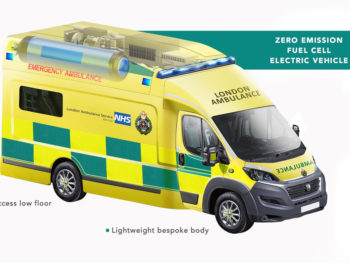UK hydrogen fuel specialist ULEMCo says it’s on track with plans to develop a prototype hydrogen fuel cell electric vehicle for the London Ambulance Service this year.

The project, named ZERRO for Zero Emission Rapid Response Operations ambulance, is funded by the Office for Zero Emission Vehicles (OZEV), and aims to deliver a prototype zero emission ambulance for the NHS Trust by autumn this year.
The agreed design is now progressing to the prototype build stage, which incorporates a hydrogen fuel cell range extender with an electric drive, low frame chassis and bespoke lightweight ambulance body designed and manufactured by Woodall Nicholson Group’s Mellor, Promech Technologies and VCS Limited.
Key design features include a low access floor that removes the need for patient lifting equipment, and a frame-based body that ensures that the overall weight of the vehicle can meet the payload requirements of the service.
The ZERRO project has marked its first birthday with the sign off of the new design. As it now moves to the build phase, the plan is to have the working prototype fully CEN approved and ready for testing in London by the autumn.
“Given the energy need of the NHS ambulance duty cycle, it seems clear that hydrogen fuel is needed to provide both the range and vehicle availability for emergency response requirements,” said Amanda Lyne, managing director of ULEMCo.
“Working with Mellor, Promech Technologies and VCS Limited, we have the advantage of designing a bespoke ambulance based on their current battery technology vehicle platform. This has enabled us to apply our capability in integrating hydrogen fuel cell range extension systems, and to prove that this will be a really viable and practical solution for NHS fleets across the UK.”
Chris Rutherford, head of fleet strategy & transformation at the London Ambulance Service, added: “This project is a key part of our strategy for a zero-emission fleet, to support the NHS aim to be the world’s first net zero national health service, and to meet or exceed the clean air requirements in London.”

